Entry Database : PDB / ID : 7jiuTitle HUMAN PI3KDELTA IN COMPLEX WITH COMPOUND 2F Phosphatidylinositol 4,5-bisphosphate 3-kinase catalytic subunit alpha isoform Keywords / / / Function / homology Function Domain/homology Component
/ / / / / / / / / / / / / / / / / / / / / / / / / / / / / / / / / / / / / / / / / / / / / / / / / / / / / / / / / / / / / / / / / / / / / / / / / / / / / / / / / / / / / / / / / / / / / / / / / / / / / / / / / / / / / / / / / / / / / / / / / / / / / / / / / / / / / / / / / / / / / / / / / / / Biological species Homo sapiens (human)Method / / / Resolution : 2.12 Å Authors Lesburg, C.A. / Augustin, M. Journal : Acs Med.Chem.Lett. / Year : 2020Title : Optimization of Versatile Oxindoles as Selective PI3K delta Inhibitors.Authors : Methot, J.L. / Achab, A. / Christopher, M. / Zhou, H. / McGowan, M.A. / Trotter, B.W. / Fradera, X. / Lesburg, C.A. / Goldenblatt, P. / Hill, A. / Chen, D. / Otte, K.M. / Augustin, M. / Shah, S. / Katz, J.D. History Deposition Jul 23, 2020 Deposition site / Processing site Revision 1.0 Jun 30, 2021 Provider / Type Revision 1.1 Mar 6, 2024 Group / Data collection / Database referencesCategory chem_comp_atom / chem_comp_bond ... chem_comp_atom / chem_comp_bond / database_2 / pdbx_unobs_or_zero_occ_atoms Item / _database_2.pdbx_database_accessionRevision 1.2 Apr 3, 2024 Group / Category
Show all Show less
 Open data
Open data Basic information
Basic information Components
Components Keywords
Keywords TRANSFERASE / TRANSFERASE-TRANSFERASE INHIBITOR COMPLEX
TRANSFERASE / TRANSFERASE-TRANSFERASE INHIBITOR COMPLEX Function and homology information
Function and homology information regulation of cellular respiration /
regulation of cellular respiration /  phosphatidylinositol 3-kinase complex /
phosphatidylinositol 3-kinase complex /  anoikis / Nephrin family interactions / 1-phosphatidylinositol-4-phosphate 3-kinase activity / Costimulation by the CD28 family / vascular endothelial growth factor signaling pathway / 1-phosphatidylinositol-4,5-bisphosphate 3-kinase activity / MET activates PI3K/AKT signaling / PI3K/AKT activation /
anoikis / Nephrin family interactions / 1-phosphatidylinositol-4-phosphate 3-kinase activity / Costimulation by the CD28 family / vascular endothelial growth factor signaling pathway / 1-phosphatidylinositol-4,5-bisphosphate 3-kinase activity / MET activates PI3K/AKT signaling / PI3K/AKT activation /  phosphatidylinositol-4,5-bisphosphate 3-kinase / phosphatidylinositol 3-kinase complex, class IA /
phosphatidylinositol-4,5-bisphosphate 3-kinase / phosphatidylinositol 3-kinase complex, class IA /  phosphatidylinositol 3-kinase / relaxation of cardiac muscle / phosphatidylinositol-3-phosphate biosynthetic process / 1-phosphatidylinositol-3-kinase activity / negative regulation of macroautophagy / Signaling by ALK / PI-3K cascade:FGFR3 / Erythropoietin activates Phosphoinositide-3-kinase (PI3K) / protein kinase activator activity / response to dexamethasone / PI-3K cascade:FGFR2 / PI-3K cascade:FGFR4 / PI-3K cascade:FGFR1 / CD28 dependent PI3K/Akt signaling / Synthesis of PIPs at the plasma membrane / phosphatidylinositol phosphate biosynthetic process / PI3K events in ERBB2 signaling / Signaling by ALK fusions and activated point mutants / negative regulation of anoikis / RET signaling / regulation of multicellular organism growth /
phosphatidylinositol 3-kinase / relaxation of cardiac muscle / phosphatidylinositol-3-phosphate biosynthetic process / 1-phosphatidylinositol-3-kinase activity / negative regulation of macroautophagy / Signaling by ALK / PI-3K cascade:FGFR3 / Erythropoietin activates Phosphoinositide-3-kinase (PI3K) / protein kinase activator activity / response to dexamethasone / PI-3K cascade:FGFR2 / PI-3K cascade:FGFR4 / PI-3K cascade:FGFR1 / CD28 dependent PI3K/Akt signaling / Synthesis of PIPs at the plasma membrane / phosphatidylinositol phosphate biosynthetic process / PI3K events in ERBB2 signaling / Signaling by ALK fusions and activated point mutants / negative regulation of anoikis / RET signaling / regulation of multicellular organism growth /  insulin receptor substrate binding /
insulin receptor substrate binding /  Interleukin-3, Interleukin-5 and GM-CSF signaling / PI3K Cascade /
Interleukin-3, Interleukin-5 and GM-CSF signaling / PI3K Cascade /  intercalated disc / positive regulation of TOR signaling / endothelial cell migration / RAC2 GTPase cycle / GAB1 signalosome / Role of phospholipids in phagocytosis / Role of LAT2/NTAL/LAB on calcium mobilization / adipose tissue development / Interleukin receptor SHC signaling / positive regulation of lamellipodium assembly /
intercalated disc / positive regulation of TOR signaling / endothelial cell migration / RAC2 GTPase cycle / GAB1 signalosome / Role of phospholipids in phagocytosis / Role of LAT2/NTAL/LAB on calcium mobilization / adipose tissue development / Interleukin receptor SHC signaling / positive regulation of lamellipodium assembly /  phagocytosis / Signaling by PDGFRA transmembrane, juxtamembrane and kinase domain mutants / Signaling by PDGFRA extracellular domain mutants /
phagocytosis / Signaling by PDGFRA transmembrane, juxtamembrane and kinase domain mutants / Signaling by PDGFRA extracellular domain mutants /  energy homeostasis / Signaling by FGFR4 in disease / Signaling by FLT3 ITD and TKD mutants / cardiac muscle contraction / Signaling by FGFR3 in disease / GPVI-mediated activation cascade / Tie2 Signaling / Signaling by FGFR2 in disease / RAC1 GTPase cycle / T cell costimulation / response to muscle stretch / Signaling by FLT3 fusion proteins / FLT3 Signaling / Signaling by FGFR1 in disease / Downstream signal transduction / insulin-like growth factor receptor signaling pathway / Signaling by phosphorylated juxtamembrane, extracellular and kinase domain KIT mutants / response to activity / liver development / phosphatidylinositol 3-kinase/protein kinase B signal transduction / Regulation of signaling by CBL / cellular response to glucose stimulus / positive regulation of smooth muscle cell proliferation /
energy homeostasis / Signaling by FGFR4 in disease / Signaling by FLT3 ITD and TKD mutants / cardiac muscle contraction / Signaling by FGFR3 in disease / GPVI-mediated activation cascade / Tie2 Signaling / Signaling by FGFR2 in disease / RAC1 GTPase cycle / T cell costimulation / response to muscle stretch / Signaling by FLT3 fusion proteins / FLT3 Signaling / Signaling by FGFR1 in disease / Downstream signal transduction / insulin-like growth factor receptor signaling pathway / Signaling by phosphorylated juxtamembrane, extracellular and kinase domain KIT mutants / response to activity / liver development / phosphatidylinositol 3-kinase/protein kinase B signal transduction / Regulation of signaling by CBL / cellular response to glucose stimulus / positive regulation of smooth muscle cell proliferation /  regulation of protein phosphorylation / Constitutive Signaling by EGFRvIII / Signaling by ERBB2 ECD mutants / epidermal growth factor receptor signaling pathway / Signaling by ERBB2 KD Mutants / Signaling by SCF-KIT /
regulation of protein phosphorylation / Constitutive Signaling by EGFRvIII / Signaling by ERBB2 ECD mutants / epidermal growth factor receptor signaling pathway / Signaling by ERBB2 KD Mutants / Signaling by SCF-KIT /  platelet activation / VEGFA-VEGFR2 Pathway / cellular response to insulin stimulus / glucose metabolic process / Constitutive Signaling by Aberrant PI3K in Cancer
platelet activation / VEGFA-VEGFR2 Pathway / cellular response to insulin stimulus / glucose metabolic process / Constitutive Signaling by Aberrant PI3K in Cancer
 Homo sapiens (human)
Homo sapiens (human) X-RAY DIFFRACTION /
X-RAY DIFFRACTION /  SYNCHROTRON /
SYNCHROTRON /  MOLECULAR REPLACEMENT / Resolution: 2.12 Å
MOLECULAR REPLACEMENT / Resolution: 2.12 Å  Authors
Authors Citation
Citation Journal: Acs Med.Chem.Lett. / Year: 2020
Journal: Acs Med.Chem.Lett. / Year: 2020 Structure visualization
Structure visualization Molmil
Molmil Jmol/JSmol
Jmol/JSmol Downloads & links
Downloads & links Download
Download 7jiu.cif.gz
7jiu.cif.gz PDBx/mmCIF format
PDBx/mmCIF format pdb7jiu.ent.gz
pdb7jiu.ent.gz PDB format
PDB format 7jiu.json.gz
7jiu.json.gz PDBx/mmJSON format
PDBx/mmJSON format Other downloads
Other downloads https://data.pdbj.org/pub/pdb/validation_reports/ji/7jiu
https://data.pdbj.org/pub/pdb/validation_reports/ji/7jiu ftp://data.pdbj.org/pub/pdb/validation_reports/ji/7jiu
ftp://data.pdbj.org/pub/pdb/validation_reports/ji/7jiu Links
Links Assembly
Assembly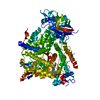
 Components
Components
 Homo sapiens (human)
Homo sapiens (human) phosphatidylinositol-4,5-bisphosphate 3-kinase,
phosphatidylinositol-4,5-bisphosphate 3-kinase,  non-specific serine/threonine protein kinase
non-specific serine/threonine protein kinase Water
Water X-RAY DIFFRACTION / Number of used crystals: 1
X-RAY DIFFRACTION / Number of used crystals: 1  Sample preparation
Sample preparation
 SYNCHROTRON / Site:
SYNCHROTRON / Site:  SLS
SLS  / Beamline: X06SA / Wavelength: 1.00003 Å
/ Beamline: X06SA / Wavelength: 1.00003 Å : 1.00003 Å / Relative weight: 1
: 1.00003 Å / Relative weight: 1  Processing
Processing :
:  MOLECULAR REPLACEMENT
MOLECULAR REPLACEMENT Movie
Movie Controller
Controller



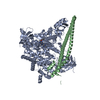




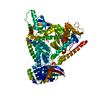
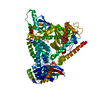
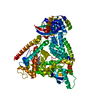



 PDBj
PDBj



















